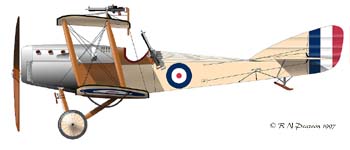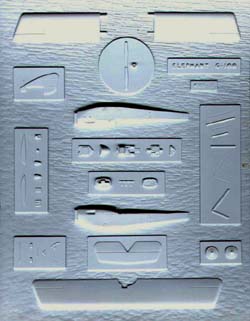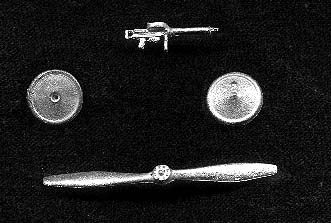 Roseplane 1/72 Martinsyde G.102 Elephant Roseplane 1/72 Martinsyde G.102 Elephant
The Martinsyde G.100/G.102 Designed in 1915 by the Martinsyde Ltd. company of Brooklands, Weybridge to fulfill the role of long range bombing and reconnaissance, the G.100 was a large twin bay aircraft with over five hours endurance. Abnormally large for a single seater, it was designed in a time before air-to-air combat was a reality on the Western Front. No.27 Squadron was the only Royal Flying Corps squadron to be fully equipped with the type, though the 120 hp G.100 and its later 160 hp variant the G.102 was on strength with 19 other Royal Flying Corps squadrons and an Australian Flying Corps squadron. The G.100 earned the nickname the "Elephant" and No.27 proudly wore an emblem of an Elephant on the sides of their aircraft. Though the G.100 was also affectionately called the 'tinsyde as well. The large wingspan of the 'tinsyde allowed for large bombloads to be lifted. Though by mid-1916 with more modern fighters coming to the front, such as the Albatros, the single seat configuration and the large wingspan meant that no one was watching the aircraft's tail and it was slow to maneuver. Subsequently the type was used on other Fronts where the aircraft it was opposing weren't as modern or as numerous, being used extensively in Macedonia, Palestine and Mesopotamia. Again predominantly in the long range bombing role. The 'tinsyde figured in the episode featuring the only air Victoria Cross won in the Palestinian campaign, when Lt. Frank McNamara attempted to pick up Lt Rutherford after he had been forced down. McNamara alighted in his Martinsyde and picked up Rutherford, but as McNamara was wounded in the upper leg, he couldn't control the swing of the Martinsyde on take off, the machine's undercarriage collapsing, They restarted Rutherford's original machine and returned to their aerodrome, McNamara close to fainting due to loss of blood for most of the return journey. The Kit  The kit comes with three sheets of instructions and information, which contain significant detail on the 'tinsyde and on the assembly process of what goes where. There is also the painting instructions for 7507, a No.26 Sqn RFC aircraft though there are no decals with the kit. The kit comes with three sheets of instructions and information, which contain significant detail on the 'tinsyde and on the assembly process of what goes where. There is also the painting instructions for 7507, a No.26 Sqn RFC aircraft though there are no decals with the kit. The vacuum shaped parts are on one sheet, which contain the wings, the tail surfaces, two fuselage halves, molded wheel covers, radiator, cockpit and the details for a camera to sling along the side of the model. Components such as the struts, undercarriage struts, and other smaller components are on the vac sheet as blanks or templates to measure against. Also as part of the sheet is the propeller. The cockpit components are quite detailed and composed of five parts. The moulding is quite detailed and has crisp edges with the sheet. The kit also come with four white metal parts, a Lewis Gun, a propeller and two wheels. There are also three strips of styrene rod that come with the kit, for the struts.. Conclusion  The Roseplane Martinsyde vacform is an excellent kit of an interesting and relatively unknown subject and should provide the basis for an experienced vac modeller or someone prepared to have a go at a vac, the basis for a model of the Martinsyde. As the main difference between the G.100 and G.102 was predominantly the hp of the Beardmore engine, a representation of either variant can be built from this kit with ease. For the keen WWI modeller, the 'tinsyde also offers the opportunity for an obscure PC12 scheme from the Middle East. The Roseplane Martinsyde vacform is an excellent kit of an interesting and relatively unknown subject and should provide the basis for an experienced vac modeller or someone prepared to have a go at a vac, the basis for a model of the Martinsyde. As the main difference between the G.100 and G.102 was predominantly the hp of the Beardmore engine, a representation of either variant can be built from this kit with ease. For the keen WWI modeller, the 'tinsyde also offers the opportunity for an obscure PC12 scheme from the Middle East.
| 


 




    |